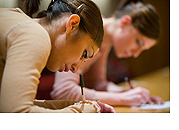|
||||||||||||||
Using
the Web - Internet literacy and Web 2.0 tools Using
the internet is a fundamental requirement in contemporary study as well
as research and demands a number of skills. Unfortunately the easily acquired
browser skills are often the end of the skills development and too often
limited to using Google. The developments in technology associated with
what is often called Web 2.0 have extended potential use by enabling users
to input rather than simply receive data, and to collaborate remotely –
anytime, anywhere, using online applications. Using
the internet is a fundamental requirement in contemporary study as well
as research and demands a number of skills. Unfortunately the easily acquired
browser skills are often the end of the skills development and too often
limited to using Google. The developments in technology associated with
what is often called Web 2.0 have extended potential use by enabling users
to input rather than simply receive data, and to collaborate remotely –
anytime, anywhere, using online applications.A discerning student should be able to use a variety of different search tools, know when they are appropriate but also be aware of how to find out more than is immediately obvious e.g. who is behind the site, what’s is its purpose, likely bias, etc. Is there some measure of authority with which information from the site can be taken, is it up to date? What other sites link to it, or are cited within it. This wider capability in terms of using the internet, itself demanding critical thinking is known variously as internet or information literacy and may also include elements of safe use.  This
resource does not specifically link with Web 2.0 but taking into account
the topicality and some of the more recent ideas in teaching and learning,
might gain from exploiting Web 2.0. A range of products enable collaboration
and sharing online and include word processors, spreadsheets, presentation
packages, internet research(bookmarking), image and general social networking
tools with educational use, wikis, blogs and podcasting. Set against an
essay, worksheet or even a PowerPoint presentation, many of these have more
appeal and can have more value e.g. a college wiki on climate change, a
blog on anthropogenic activity, or a group glossary. This
resource does not specifically link with Web 2.0 but taking into account
the topicality and some of the more recent ideas in teaching and learning,
might gain from exploiting Web 2.0. A range of products enable collaboration
and sharing online and include word processors, spreadsheets, presentation
packages, internet research(bookmarking), image and general social networking
tools with educational use, wikis, blogs and podcasting. Set against an
essay, worksheet or even a PowerPoint presentation, many of these have more
appeal and can have more value e.g. a college wiki on climate change, a
blog on anthropogenic activity, or a group glossary. Apart from the appeal and fashion aspect of their use, they mesh well with e.g. co-operative and collaborative learning, online learning, peer assessment and review and can support higher order thinking. With “internet literate students” they can develop their own “live” learning resources and add to an institution’s resource as well as illustrating student work. With the government pressure on learning platforms and individual student portfolios and repositories, they are the tools for e-learning. |
||||||